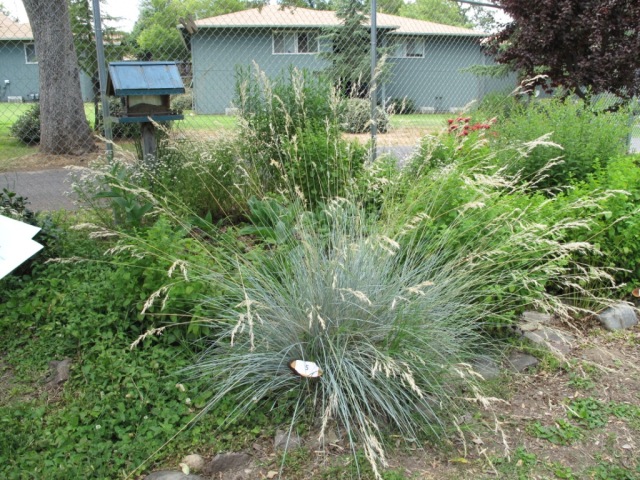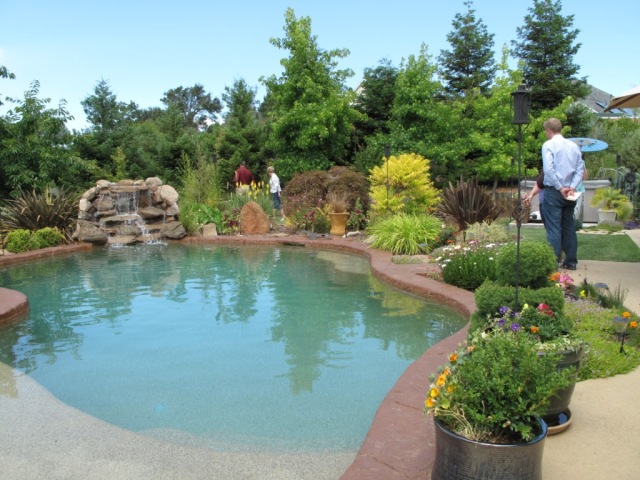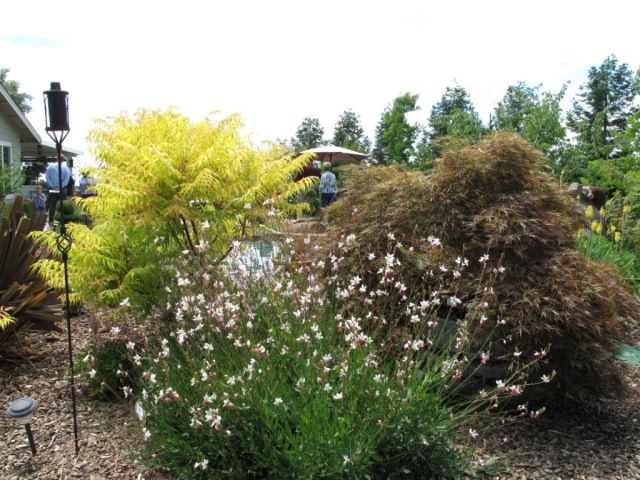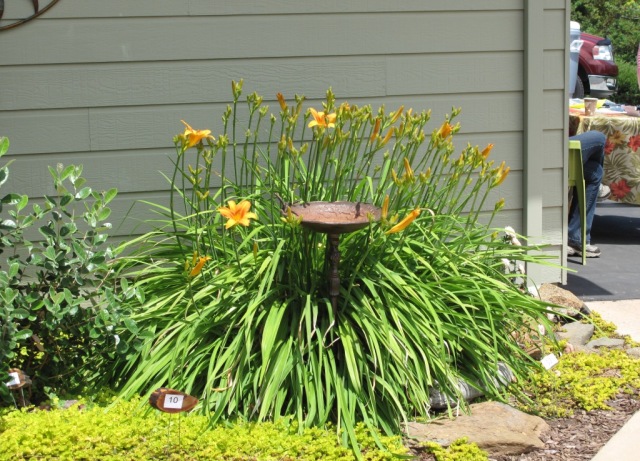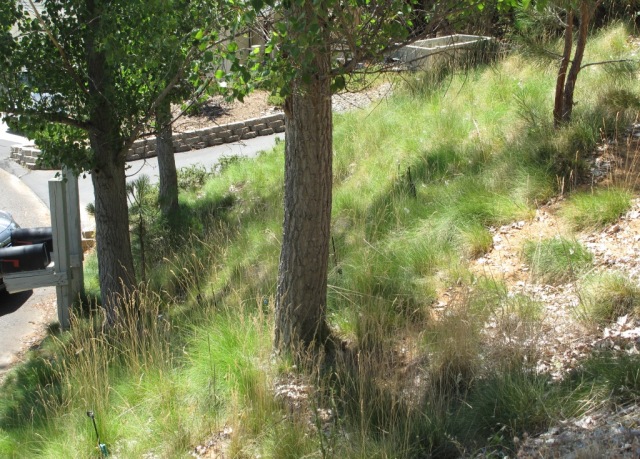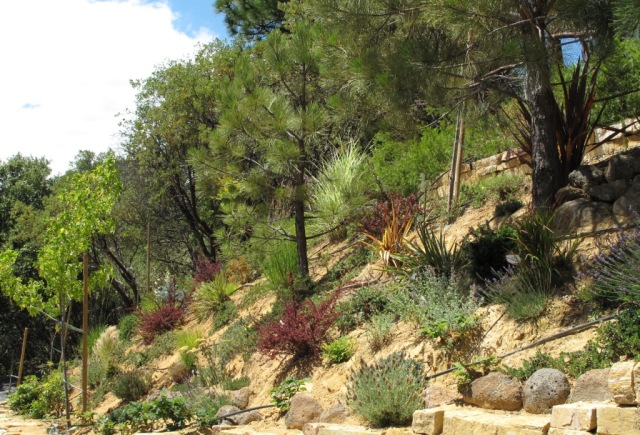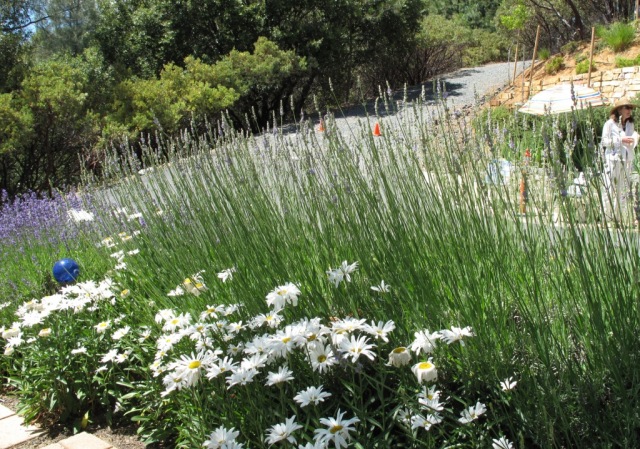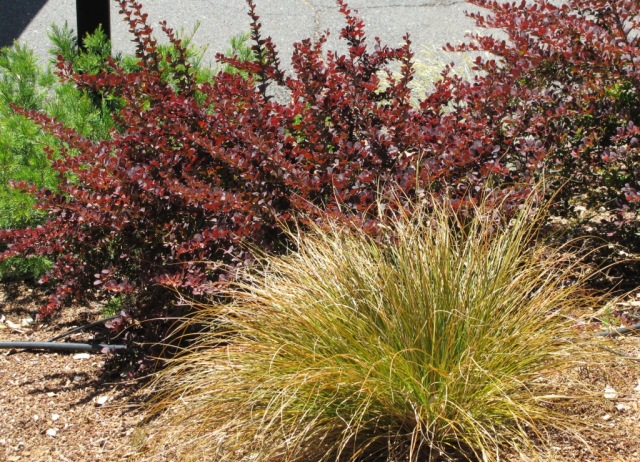Last Sunday, I joined a friend for the Tuolumne master gardeners’ garden tour. For those of you not enamored of gardening, this post may get a bit long. The photos are simply “quickly snapped records”. First up (below), the demonstration garden in Sonora:
Purple coneflower, Echinacea – This is something I did start seed of; we’ll see if they get big enough by fall to survive the winter,
Woolly yellow yarrow, Achillea tomentosa – Stopped by Murphy’s nursery and picked up one of these as it looks like a great dry garden addition.
Walking onion – Mentioned I’ve been looking at getting some of these and was generously handed a ripe seed head. They’re called walking onion as in addition to the bulb in the ground they form small bulbs at the end of their stems. These then fall to the ground and grow; thus your onion plants walk or travel across your garden.
Debated about including this picture, but I have a few friends who’d like to see it. That monster shrub smack dab in the center is a butterfly bush (Buddleia davidii). Most of us keep them as a small shrub. I think Sunset recommends cutting them to two or 3 feet each winter. The other point of interest for the crafting folks is the partially completed drinking fountain. You can see a bit of rebar, the wire frame and that they’ve been mortaring stones from the base up.
The community garden in Twain Harte planted pollinators all around the fenced perimeter with herb and flower beds beautifully done within. For anyone in that neck of the woods I understand they still have raised beds available for rental.
I want to remember the blue oat grass as it looks precisely like blue fescue although double the size. Mixing the two could be interesting.
Now we’re into the private gardens. These folks used seven hoops on their beds, where I used only four. I think it’s a smart move on their part as it’s a much better support for row cover in winter when snow might weigh it down.
Love horsetail, but I have no plans for a water feature as that would be a sure lure for the larger critters I’m not looking to attract my garden.
This is another ‘note to self’ picture. I have small hardy passion vines (Passiflora caerulea) that I’ve been nursing since digging bits up from my previous home. Nice to know if I move them off the porch (but keep them close to a structure), they may survive.
Although red-hot poker (“torch lily, Kniphofia – also called tritoma) is on my list of plants to get, I’m liking the yellow these folks used in quite a few places. My absolute fav is a stunning red I’ve seen locally.
My little seed started Gaura Whirling Butterflies are just one wispy fragile stem. It will take more than a few years for them to reach this size. But, when they do they are one of the re-blooming stars of hot, dry summers.
I actually love Mexican Evening Primrose (Oenothera berlandierii). For awhile in California it was overdone and in the warmer zones it takes off like a pernicious weed. My gardening friends in the Bay Area would shudder at the thought of planting it.
If I ever get my garden in (loud sigh, forget “Hawaiian time” the guy I’d hired for some things is on “Molasses time”) need to remember that something like a birdbath/feature in the middle of a large flower clump (daylilies, hemerocallis) is an easy “pop”.
Although they do take a bit of water to look good, we saw Shasta daisies (Leucanthemum superbum) in pretty much every garden visited. They have a strong scent (a reason why some folks won’t plant them) which helps them survive our various critters. My phormiums (big spiky things) bit the dust a few years back. This garden is a tad lower elevation with a bit more warmth in the winters.
Easy to ignore, this hillside is the result of someone carefully killing off all the weeds (no small feat out here with everyone close to constantly weedy open space) then carefully putting in irrigation and planting this tufting grass. I’m not sure which one it is – like a stipa, but stipa has a more feathery plume.
Dwarf grey santolina is another at the top of my wish list (I know High Country Gardens has one called “nana”, if I can get it from a local nursery first, I will). Lavenders are the “go to” plant in this area, so they’re easily found in all varieties.
Trailing rosemary really takes off here, if you don’t let it get woody, it’s a great culinary herb with beautiful small blue flowers.
Manzanita branches (abundant when you clear a space for planting) are the railings.
If critters don’t chew through the above ground irrigation lines, each of those plants should triple in size resulting in a many hued hillside. Critters chew through them underground as well, so you’ll see many folks leave them where they have easy access. For my meager beds and planting, the plan is PVC for all the main lines as once in, they’ll be so much less maintenance (some, but less).
Note to self about heuchera, hydrangea and phlox (plus I like the birdhouses, although mine are always occupied and birds do their business where they live, not a pretty site).
People in this region do go to lengths others don’t have to in order to grow their favored plants. I’m thinking this would be great with climbing vines.
Hiding the propane tank plus the wood, rebar and filler method of easy stairs I’ll most likely resort to on the sloping sides of my house.
More shastas with lavender, that’s Julie – my master gardener “tour guide” in the hat (not sure I’d have found my way around the recesses of Twain Harte without her).
Berberis thunbergii (a barberry) with copper carex. If you ever watch Bing Bang Theory and see them leafing through comics in harmony – “got it, got it, got it, got it, got it, got it, got it, got it, got it, got it), I have a similar mantra – “had it, killed it, had it, killed it, had it, killed it, had it, killed it, had it, killed it”. Keeping potted plants alive in summers that tap 100s for weeks is not an easy task (see molasses comment, intent was never to try to keep them in pots for years). These have both met that fate. Won’t let myself get another until the beds are in.






